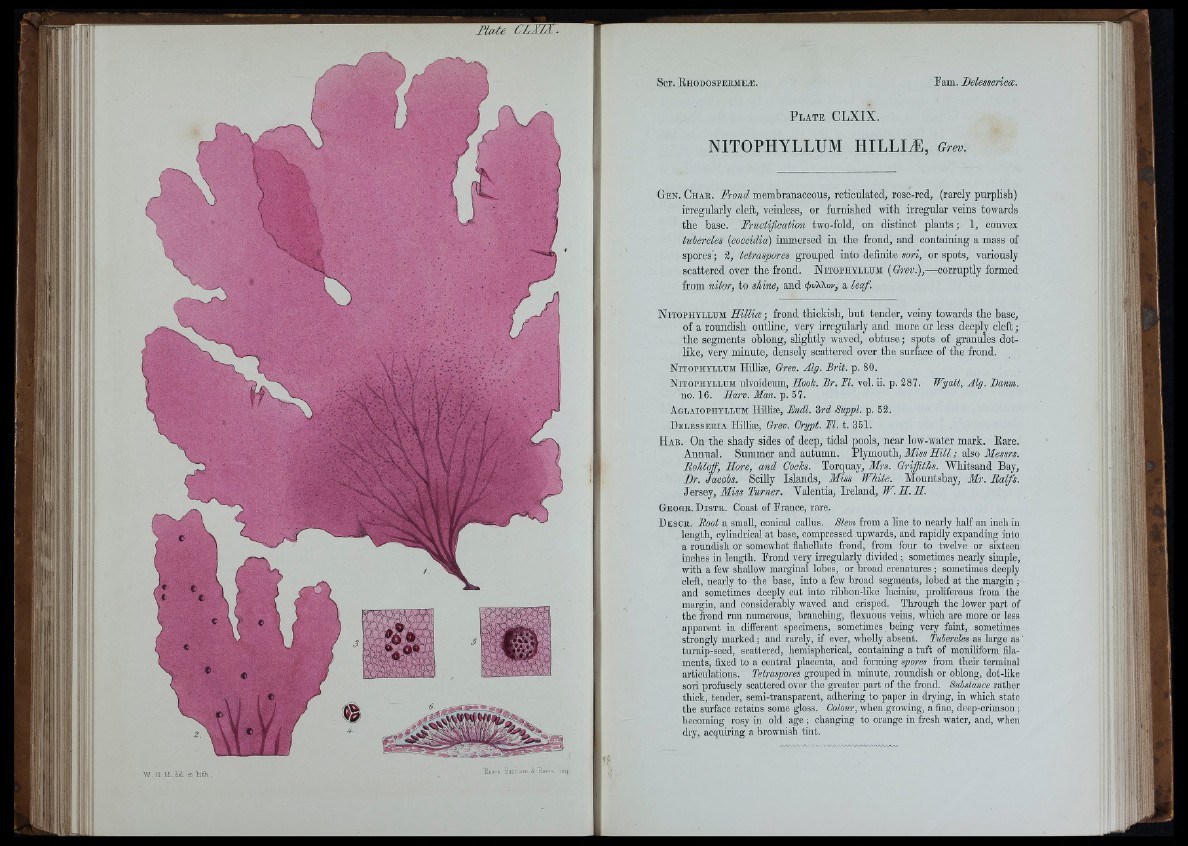
P la t e C L X IX .
NITOPHYLLUM HILLIÆ, Grev.
h '
G e n . C h a e . Frond m embranaceous, re tic u la ted , ro se-red, (rarely p u rp lish )
irreg u la rly cleft, veinless, or fu rn ish e d w ith irr e g u la r veins towards
th e base. Fructification two-fold, o n d is tin c t p l a n t s ; 1, convex
tuhercles [coccidia) imm.ersed in th e fro n d , an d c o n ta in in g a mass of
spores'; 2, tetraspores g ro u p ed in to deikiite sori, or spots, variously
s c a tte re d over th e fro n d . N i t o p h y l l u m [G rev),— c o rru p tly formed
from nitor, to shine, an d fivWov, a leaf.
N i t o p h y l l u m H iiïia -, frond tliickish, but tender, veiny towards the base,
of a roundish outline, very irregularly and more or less deeply cleft ;
the segments oblong, slightly waved, obtuse ; spots of granules dot-
hke, very minute, densely scattered over the surface of the frond.
N itophyllum HiUiæ, Grev. Alg. Brit. p. 80.
N itophyllum ulvoideum, Book. Br. M. vol. ii. p. 287. Wyatt, Alg. Banm.
no. 16. Harv. Man. p. 57.
Aglaiophyllum Hüliæ, Fndl. 3rd Swppl. p. 52.
D e l e s s e e ia Hilhæ, Grev. Crypt. FI. t. 351.
H a b . On the shady sides of deep, tidal pools, near low-water mark. Rare.
Annual. Summer and autumn. Plymouth, Miss H ill ; also Messrs.
Rohloff, Hore, and Cocks. Torquay, Mrs. Griffiths. Whitsand Bay,
B r . Jacobs. Soilly Islands, Miss White. Mountsbay, M r. R a lfs.
Jersey, Miss Turner. Yalentia, Ireland, W .H .H .
Geoge. D is t e . Coast of France, rare.
D e s c e . Root a small, conical caUus. Stem fi-om a Une to nearly half an inch in
length, cylindrical at base, compressed upwards, and rapidly expanding into
a roundish or somewhat flabellate frond, from four to twelve or sixteen
inches in length. Frond vei-y irregularly divided ; sometimes nearly simple,
with a few shallow marginal lobes, or broad crenatures ; sometimes deeply
cleft, neai-ly to the base, into a few broad segments, lobed at the margin ;
and sometimes deeply cut into rihhon-like laciniæ, proliferous from the
margin, and considerably waved and crisped. Through the lower part of
the frond run numerous, branching, flexuous veins, which are more or less
apparent in different specimens, sometimes being very faint, sometimes
strongly marked ; and rarely, if ever, wholly absent. Tubercles as large as
turnip-seed, scattered, hemispherical, containing a tuft of moniliform filaments,
fixed to a central placenta, and forming spores from their terminal
articulations. Tetraspores grouped in minute, roundish or oblong, dot-like
sori profusely scattered over the greater part of the frond. Substance rather
thick, tender, semi-transparent, adhering to paper in drying, in which state
the surface retains some gloss. Colour, when growing, a fine, deep-crimson ;
becoming rosy in old age ; changing to orange in fresh water, and, when
dry, acquiring a brownish tint.
.'1